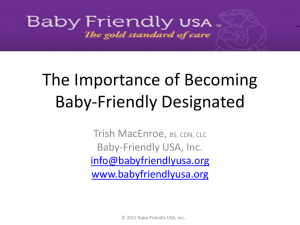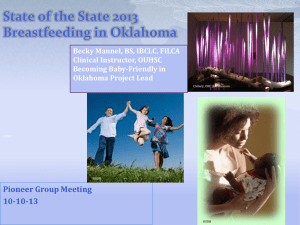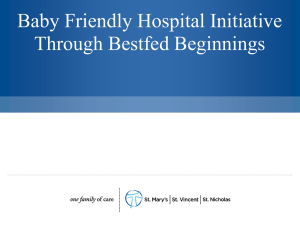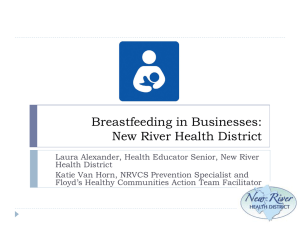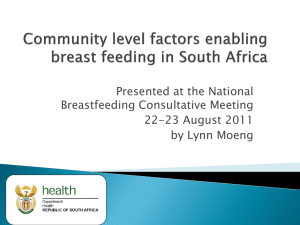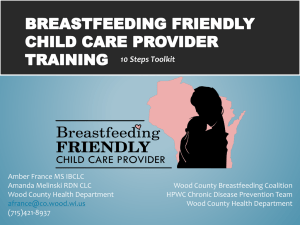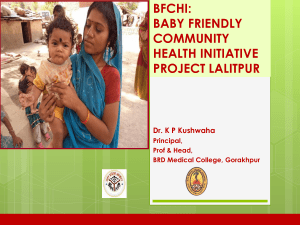The New 4-D Pathway - College of Continuing Education
advertisement
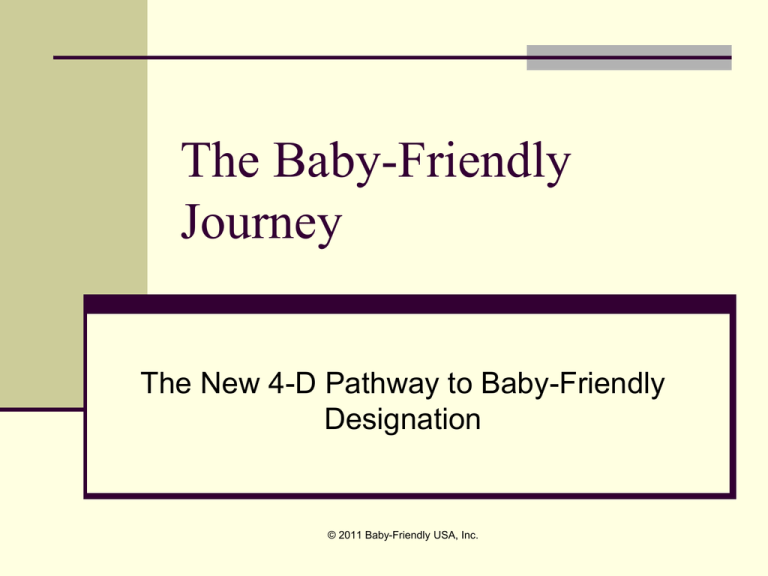
The Baby-Friendly Journey The New 4-D Pathway to Baby-Friendly Designation © 2011 Baby-Friendly USA, Inc. Speaker Disclosure The speaker discloses employment with Baby-Friendly USA, Inc. There are no other conflicts of interest. This presentation is not supported by any funds from companies that violate the International Code of Marketing of Breastmilk Substitutes What is the Baby-Friendly Hospital Initiative? (BFHI) A QI and recognition program for maternity facilities that have created an optimal environment for appropriate infant feeding and mother-baby bonding. An international program co-administered by the World Health Organization (WHO) and the United Nations Children’s Fund (UNICEF) in conjunction with national BFHI authorities. Background of BFHI Internationally Ten Steps to Successful Breastfeeding, published by WHO & UNICEF in 1989 Innocenti Declaration (1990/2005) International Code of Marketing of Breast-milk Substitutes (the “Code”) 1981 http://whqlibdoc.who.int/publications/9241561300.pdf www.innocenti15.net http://www.who.int/nutrition/publications/code_english.pdf The Evidence The Ten Steps to Successful Breastfeeding have been demonstrated to increase both initiation and duration of breastfeeding DiGirolamo AM, LM.Grummer-Strawn and SB Fein. 2008. Effect of Maternity-Care Practices on Breastfeeding Pediatrics122;S43-S49 Merten, S, et al. 2005. Do Baby-Friendly Hospitals Influence Breastfeeding Duration on a National Level? Pediatrics 116; e702-e708. Philipp BL et al. 2001. Baby-Friendly Hospital Initiative Improves Breastfeeding Initiation Rates in a US Hospital Setting. Pediatrics 108(3):677-681. DiGirolamo AM, LM Grummer-Strawn, S Fein. 2001. Maternity care practices: implications for breastfeeding. Birth 28:94-100. Kramer MS et al. 2001. Promotion of Breastfeeding Intervention Trial (PROBIT): A randomized trial in the Republic of Belarus. JAMA 285:413 The US Data 110 designated “Baby-Friendly” hospitals and birth centers ~300 hospitals and birth centers have officially signaled their plans to complete the process More are on the way… Answering the Nation’s Call Why Pursue Baby-Friendly Designation? © 2011 Baby-Friendly USA, Inc. Recommendation 1.3: Hospitals and health care providers should use maternity care practices that empower new mothers to breastfeed, such as the Baby-Friendly hospital standards. Recommendation 1.3: Hospitals and health care providers should use maternity care practices that empower new mothers to breastfeed, such as the BabyFriendly hospital standards. http://www.letsmove.gov/pdf/TaskForce_on_Childhood_Obesity_May2010_FullReport.pdf WHY Pursue Baby-Friendly Designation? Healthy People 2020 goals Increase the proportion of infants being breastfed Ever to 81.9% At 6 months to 60.5% At 1 year to 34.1% Exclusively through 3 months to 44.3% Exclusively through 6 months to 23.7% Studies show that the BabyFriendly Hospital Initiative increases BF initiation and duration WHY Pursue Baby-Friendly Designation? Healthy People 2020 goals Increase the proportion of live births that occur in facilities that provide recommended care for lactating mothers and babies Baby-Friendly Hospital Initiative implements the Ten Steps to Successful Breastfeeding, which is that recommended care WHY Pursue Baby-Friendly Designation? Healthy People 2020 goals Reduce the proportion of breastfed newborns who receive formula supplementation within the first 2 days of life Joint Commission Perinatal Core Measures track exclusive breastmilk feeding Step 6 – Give newborn infants no food or drink other than breastmilk, unless medically indicated WHY Pursue Baby-Friendly Designation? ACTION 7. Ensure that maternity care practices throughout the United States are fully supportive of breastfeeding. Accelerate implementation of the Baby-Friendly Hospital Initiative. The Pathway to Baby-Friendly® Designation Dissemination Collect Data Baby-Friendly Designation Designation Bridge to Designation Phase Dissemination Certificate of Completion Implement QI Plan Readiness Interview On-Site Assessment Train Staff Bridge to Dissemination PhaseDevelopmentCertificate of Completion Data Collection Plan Prenatal/Postpartum Teaching Plans Staff Training Curriculum Development Start Discovery Register with Baby-Friendly USA Obtain CEO Support Letter Complete Self Appraisal Tool Bridge to Development PhaseRegistry of Intent Award Hospital Breastfeeding Policy BFHI Work Plan BF Committee Or Task Force The Baby-Friendly Journey 4 – D Pathway tools to prepare for the on-site assessment © 2011 Baby-Friendly USA, Inc. DISCOVERY Information Packet What is the BFHI 10 Steps International Code of Marketing of Breastmilk Substitutes Self Appraisal Tool Sample CEO Support Letter DEVELOPMENT Guidelines and Evaluation Criteria Workplan template/Model Action Plans Budget planner Policy development tool Policy check off tool Community survey Patient education tool DEVELOPMENT Staff training requirements Staff education documentation tool Quality improvement plan template BFHI power point presentation BFUSA Support Review and provide feedback Workplan Infant feeding policy Staff training plan Patient education plan Data collection plan DISSEMINATION Audit tools Code implementation Policy implementation Staff competency Staff knowledge Training implementation Patient knowledge Infant Feeding Outcomes DESIGNATION BFUSA and Facility participate in Readiness Assessment Telephone Interview Facility works with purchasing department to implement requirement to purchase infant formula, bottles and nipples Facility preparation for the on-site assessment materials BFUSA support in planning for your on-site assessment Reasons facilities have not passed on first assessment And Baby-Friendly USA, Inc. Responses © 2011 Baby-Friendly USA, Inc. Reasons for not passing the first assessment The facility has not embraced the initiative, Baby-Friendly is viewed as a lactation department project. The facility is not always aware that the maternity department is even working towards Baby-Friendly designation BFUSA Response Discovery Phase - Require CEO Letter of Support Development Phase - Require formation of multi- disciplinary team to implement the Guidelines and Evaluation Criteria Development Phase - Require multi-disciplinary team to review the results of mPINC and BFUSA selfappraisal tool and develop a workplan to address low scoring areas Development Phase - BFUSA reviews and provides feedback on plan Reasons for not passing the first assessment Facility breastfeeding/infant feeding policy and/or supporting documents are not comprehensive Facility has other policies, protocols and or procedures that countermand the breastfeeding/infant feeding policy BFUSA Response Development Phase – Provide a policy development guidance tool Development Phase – Provide a policy check off tool Development Phase – BFUSA reviews and provides feedback on the policy Dissemination Phase – Provide a Quality Improvement Audit tool Designation Phase – inquire about policy changes, review policy during assessment Reasons for not passing the first assessment Records on the day of assessment show that staff are not fully trained Initial training complete, but new employees have not received the required training Staff training took place too close to assessment, skills are not fully integrated Staff competencies were not verified BFUSA Response Development Phase – Require a comprehensive training plan to address initial training, new hire training, competency verification and continuing education Development Phase – Provide the list of required training topics Development Phase – Provide a spreadsheet to document training Development Phase – BFUSA reviews and provides feedback on training plans BFUSA Response Dissemination Phase – Provide Quality Improvement Audit Tools Designation Phase – inquire about training, review training records during assessment Reasons for not passing the first assessment Patient education is fragmented, incomplete and undocumented BFUSA Response Development Phase – Require development of patient education plans Development Phase – BFUSA reviews and provides feedback on patient education plans Dissemination Phase – Provide Quality Improvement Audit Tools Designation Phase – inquire about patient education, review plans, materials and records during assessment Reasons for not passing the first assessment Facilities not measuring health outcomes Facilities not measuring performance outcomes Facilities not comparing their work to the Baby-Friendly Guidelines and Evaluation Criteria. BFUSA Response Development Phase – Prepare a data collection plan Dissemination Phase- Audit health and performance outcomes QUESTIONS??? © 2011 Baby-Friendly USA, Inc.
